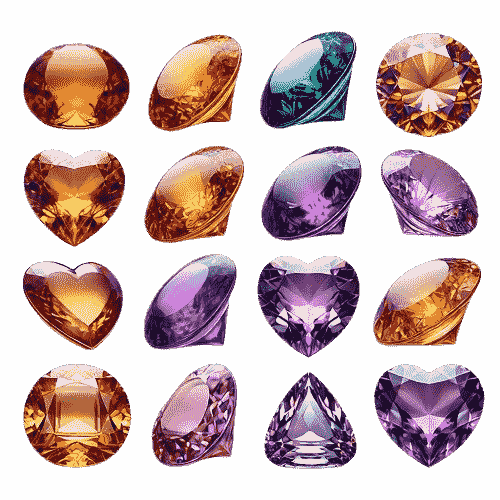THOSE BORN IN JANUARY HAVE THE BIRTHSTONE GARNET, a stone that has long been connected to strong, intense feelings. The name garnet comes from the Latin word granatus, meaning “pomegranate,” because the gem’s color resembles the rich red insides of this fruit. The stones range in their natural state from the size of a grain of sand to gems as large as an apple.
However, while we most often associate garnet with the color red, these stones are available in a rainbow of other colors like orange, yellow, purple, and green. Some garnets even change color from blue to purple in different lighting! Part of the reason for this color variation is that garnet isn’t just one stone—it’s actually a group of several minerals. Some varieties of garnet that are worn as gems include pyrope, almandine, spessartine, grossular, andradite, and tsavorite, with grossular having the widest color range among garnets.
Garnets can be found throughout the world. While Africa supplies most of the garnets available today, they are also mined in California, Russia, Eastern Europe, Myanmar, Brazil, Afghanistan, Pakistan, India, Sri Lanka, and more. Garnets are used not only in jewelry-making; they also have industrial uses such as making watch gears and are found in sandpaper and other abrasives. For February birthstone facts read here.
History and Lore
Garnets have played an important role throughout history and across cultures and religions. Red garnets were popular in jewelry worn by the pharaohs of ancient Egypt (even into the afterlife, where they have been found on mummies!), used in signet rings in ancient Rome to help stamp the wax that sealed important letters and documents, and fawned over by the clergy and nobility of the Middle Ages.

From A.D. 23–79, red garnets were among the most widely traded gems in the world, though they often went by another name back then: carbuncle, which could be used to describe a number of red gems.
In medieval times, garnets were believed to cure inflammatory diseases and help heal ailing hearts.
Ancient Greeks and Romans often wore garnets as protective talismans. The Greeks called it “the lamp stone” and said that if a garnet was hung around the neck, it could give its wearer the power to see in the dark.
Some Asiatic peoples used garnets as weapons, launching them from sling bows at their enemies; they later used them in place of bullets in their firearms. They believed the blood-colored stone would inflict more deadly wounds than leaden bullets could.
Pyrope garnets were especially beloved in Victorian times for their rich, deep red color. This variety of garnet came from Bohemia, the westernmost region of the Czech Republic, and was mined there for over three hundred years beginning in the 1500s. The Pyrope Hair Comb is a beautiful, tiara-shaped example of a surviving piece created from this Victorian garnet craze.
Uses
- Wearing garnets is believed to inspire feelings of self-confidence.
- They can also offer a sense of calm or bring strong, passionate feelings, depending on what the person most needs; it is said to be a stone of balance, helping to keep emotions in check.
- Maybe you’re looking to attract your crush; garnet is said to deepen romantic feelings.
- Garnets are also good stones to have in a crisis, as they are believed to bring courage and hope into even the darkest of situations.
- Garnets can help you with clearer thinking by encouraging you to let go of old ideas that are holding you back.
- Feeling sick and don’t have time to deal with a cold? Garnet is also believed to purify the blood and reduce toxins in the body.
- Nightmares got you down? Place a garnet under your pillow to keep away unwanted bad dreams.
Each type of garnet is believed to have its own special properties, too:
- Getting ready to run a marathon? Almandines offer strength and stamina.
- Are you trying to write a story or ace an art project? Andradite aids in creativity.
- Maybe you play a team sport. Grossular enhances cooperation and relaxation.
- If you’re feeling run-down and like you could use a boost of energy, pyrope promotes health and quality of life.
- Ready to start volunteering at your local senior home or animal shelter? Spessartine gives its wearer a willingness to help others. Got the blues? It’s also a natural antidepressant.
